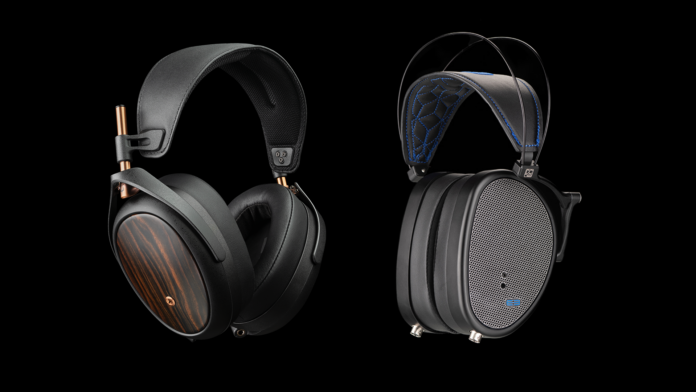On paper, there’s a lot in common between the new Meze Liric II and Dan Clark Audio’s E3. They’re both neutral-warm, closed-back, planar-dynamic headphones that clock in at $1,999. Yet in my experience with them, I actually found them to be completely distinct from one another. In this comparison review, we’ll break down everything from build, design, and sound quality to see which might be the better match for you.
What You Get
| Liric II | E3 |
|
|
Look and Feel:
Both of these headphones look and feel luxurious. The Liric II is gorgeously crafted, featuring leather ear pads, metallic yokes, and Macassar ebony wood on the ear cups. The headphone feels great to wear with appropriate clamping force, ensuring good isolation. I was able to wear these for long listening sessions without feeling any fatigue.
Meanwhile, the E3 is built more like a tank. Yes it still feels premium, but this is a little bit more rugged, which is suitable for on-the-go use. This headphone uses gorilla glass to protect its ear cups, and sports classic Dan Clark materials like a Nitinol headband and a folding mechanism for its ear cups, once again, maximizing portability. Like the Meze, clamping force feels appropriate and provides great isolation.
The Liric II ships with multiple types of cables whereas the E3 ships with your single choice of cable. Frankly, I like the Meze cable a lot more. It’s nimble but well-built. Dan Clark’s cable is bulky and stiff, feeling a bit utilitarian and inconvenient for portable use. Add in Meze’s included different cable options and you get a much more versatile set of headphones. Both cases feel compact enough for portable use but it should be noted that the E3’s ability to fold into a small case makes it just that much more convenient to take on the road.
Both headphones are marketed as being good for travel and portable listening environments, but I find the E3 more successful in that regard. However, if you’re looking for a closed back headphone for home use, both headphones will serve you well.
Design:
The Liric II and E3 each have a lot going on under the hood. Starting with the Liric II, Meze has applied its new Quarter Wavelength Resonator Mask or QWRM. The QWRM covers up select portions of the driver to help reduce harsh frequencies. Meze specifically cites frequencies at 7kHz and above as targets for the QWRM. This tech helps tailor the sound coming from the MZ4 driver that is carried over, albeit with adjusted tuning, from the original Liric.
Meanwhile, the E3 also uses an acoustic filtering system to help refine the headphone’s sound. The Acoustic Metamaterial Tuning System controls diffusion and aggressive high-frequency information to create an overall more pleasing treble response. It also uses a Dual-Mode Bass Port to enhance the bass response, making it more articulate and free of bloat.
Both headphones offer advanced technology. With either choice, you’re sure to be on the forefront of audio tech.
Low End:
Okay, let’s get into the sound of these headphones. Like I said earlier, there’s a lot in common between these headphones, especially their neutral-warm sound signatures. But the bass response is where these headphones differ the most, in my opinion. To my ear, the Liric II has a meatier bass with more dynamic punch and a boosted midbass. The E3, on the other hand, is a bit more deliberate with its bass response. You definitely hear every low end detail but you don’t quite feel it as much as you do on the Liric II.
That said, the E3 has a cleaner bass region. Every beat feels carefully rendered and low end separation is extremely impressive. The Liric II is a bit more visceral and the midbass boost makes for a more musical experience.
So if you like a clean, well-separated, and closer to balanced low end where you can hear everything, the E3 might be for you. But if you’re into a more dynamic presentation where you can feel more, then the Liric II might be the better direction.
Midrange:
Both headphones have a clean midrange. The E3 aims closer to the Harman Target, so the midrange can feel a little recessed at times. Meanwhile, the Liric II is a bit more present. And with its boosted midbass, the transition into the mids is where the Liric II’s warmth really comes from. I would probably describe both headphones’ mids as relaxed, though the Liric II is a bit more engaging. Vocals just have a little bit more detail and the layering of mid range instruments just feels more responsive and natural.
That said, the E3’s somewhat scooped midrange helps it feel a bit more open and airy. There is no bloat, just a lean but mean neutral response. I would also venture to say this midrange presentation helps to make the headphone feel a little bit more open sounding too, but I won’t spoil anything for the soundstage section.
Top End:
The top end is where these headphones sound the most similar. I guess that makes sense, though, as they both utilize filtering systems to keep the treble sounding crisp but without any harsh edges. The highs are clear and non fatiguing. If I had to choose between the two, I would say that, once again, the treble on the Liric II is just a bit more lively whereas the E3 is a little more detailed. Hi-hats are fast and exciting on the Liric II, but they’re very well controlled. The E3, however, can get a little bit harsh at times. This may actually be because of the less colored and even keeled mid range. Overall, the E3 just feels a bit thinner, which causes the high end to perhaps feel exaggerated.
Soundstage:
The Liric II and E3 both have great soundstages, but they are different. Dan Clark Audio has long been on a mission to make their closed back headphones sound like open back ones, and I think it’s reasonable to say that the E3 succeeds. Yet while it feels very wide, the sound almost feels too far away at times. Because of this, music loses some dynamic ability and sounds less exciting.
The Liric II may be just a smidge narrower but imaging feels a lot more natural and accurate. This comes from a feeling that sound is resolving outward, like an open back headphone would. While the headphone doesn’t necessarily sound the widest I’ve ever heard, its organic soundstage is extremely impressive and enjoyable to listen to.
Conclusion:
As far as closed back headphones go, you can’t go wrong with either pair. But, there are some key differences between the two and different types of listeners may prefer one over the other. If you like a headphone that goes for the Harman Target, sounds extremely wide, and presents detail in a deliberate and delicate manner, the E3 is a good direction for you. If you prefer a more visceral experience with a more natural presentation of sound, then I think the Liric II is a great choice.
The Meze Liric II and Dan Clark Audio E3 are available at Audio46.
MAJORHIFI may receive commissions from retail offers.








